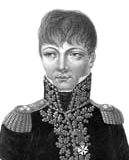General François Antoine Louis Bourcier

Born: February 21, 1760
Place of Birth: Petite-Pierre, Bas-Rhin, France
Died: May 8, 1828
Place of Death: Ville-au-Val, France
Arc de Triomphe: BOURCIER on the east pillar
Pronunciation:
A career cavalry officer, François Antoine Louis Bourcier first enlisted in the cavalry in 1772. Twenty years later in 1792 Bourcier became an aide-de-camp to the Duke of Aiguillon and the following year he joined Custine's staff. After serving at Mainz he was promoted to chef de bataillon in March of 1793 and then in October he was promoted to général de brigade and appointed chief of staff for the Army of the Rhine. In 1794 Bourcier was promoted to général de division but that July he was suspended and arrested. Not long thereafter the Thermidorian Reaction overthrew Robespierre's government and Bourcier was released to resume his position as chief of staff of the Army of the Rhine.
In 1795 Bourcier took command of the 3rd Division of the Army of the Rhine and Moselle and then the following year he took command of the 5th Division in the same army. Next Bourcier was given command of a cavalry reserve and in July he fought at Rastadt before he fought at Ingolstadt and Kehl in November. In April of 1797 he served at the crossing of the Rhine at Kehl and then that August he was named an inspector general of cavalry of the Army of the Rhine and Moselle. General Bourcier was sent to Switzerland in September of 1798 where he continued to serve as an inspector general of cavalry. The following year he joined the Army of the Rhine and continued to serve in the same capacity.
In 1802 Bourcier was named a Councilor of State and the following year he was sent to command the light cavalry at the camp of Saint-Omer. In 1804 he was named a Grand Officer of the Legion of Honor. When the Grande Armée marched to war in 1805, Bourcier assumed command of the 4th Dragoon Division. Leading his men on the campaign that fall, he served at Ulm, Elchingen , and Austerlitz. In 1806 Bourcier was recalled to Paris, but he rejoined the army at the end of September. Once back with the army, he assisted at the Battle of Jena and then he was named inspector general of cavalry and commander of the cavalry depot at Potsdam.
Bourcier must have had a talent as inspector general, for in 1808 he was named inspector general of cavalry of the Grande Armée and a Count of the Empire. That November he was ordered to take command of the cavalry depots for the Army of Spain, but in 1809 he was called to Augsbourg to take command of the cavalry depots of the Army of Germany. In 1810 Bourcier briefly returned to Spain to command the cavalry depot at Bayonne, but before long he was recalled to the Council of State and then made available to the Ministry of War.
In January of 1812 Bourcier was named commander of the cavalry depot at Hanover. After the disastrous retreat from Russia that year, he assumed command of the cavalry depot of Koenigsberg. The next year he commanded the cavalry depots of Hanover and Brunswick before taking command of the depot at Magdeburg. Trapped in Magdeburg by the besieging Coalition powers, he remained there until after Napoleon's abdication in 1814.
The restored Bourbons named Bourcier a Knight of Saint Louis and inspector general of the 8th arrondissement of cavalry. When Napoleon resumed power in 1815 for the Hundred Days, he named Bourcier commander of the cavalry depot and remounts at Versailles. After Napoleon's second abdication, Bourcier retired from the military but in 1816 he went into politics as a deputy of Meurthe. He continued to serve as a deputy until February of 1824.
Bibliography
Updated March 2025
© Nathan D. Jensen